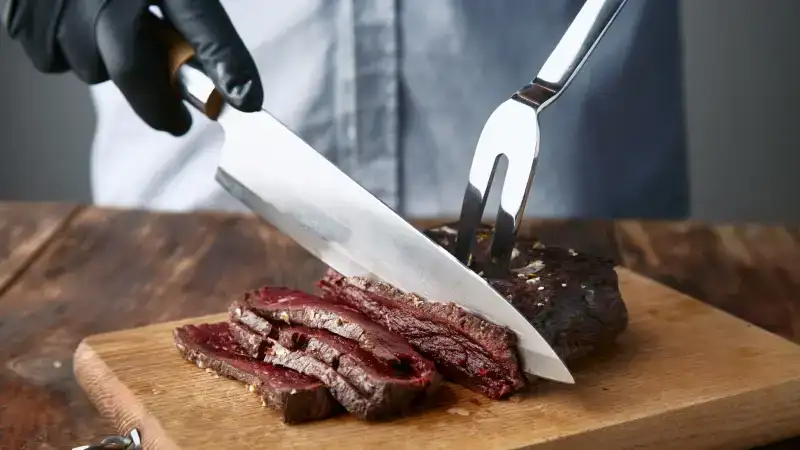When it comes to steak, achieving the perfect medium rare is a culinary art. It’s not just about the look of the seared crust or the marbling of the meat—it’s about nailing the temperature that delivers a tender, juicy bite every time. In this article, we’ll guide you through the optimal medium rare steak temp, how to measure it accurately, and tips to get that restaurant-quality steak at home.
What Is Medium Rare Steak?
Medium rare steak is celebrated for its balance between tenderness and juiciness. When prepared correctly, it features:
- A warm red center with a slightly pinkish edge.
- A temperature range of 130°F to 135°F (54°C to 57°C).
- A juicy and tender texture, with a melt-in-your-mouth quality.
This level of doneness is ideal for preserving the natural flavors of the beef, as it avoids overcooking while ensuring the meat is safe to eat.
The Science Behind Medium Rare
Cooking meat involves heat transforming proteins and fats. At the medium rare stage:
- Proteins denature: This process tightens the fibers, but at this temp, the meat remains tender.
- Juices are retained: Too high a temperature will push the juices out, leaving a drier steak.
- Fat melts: The marbling begins to render, enhancing the flavor.
How to Measure Steak Temperature
Using a meat thermometer is the most reliable way to achieve the perfect medium rare steak. Here’s how to do it:
-
Insert the Thermometer Properly
- Place the probe in the thickest part of the steak, avoiding bones or fat pockets.
-
Look for the Sweet Spot
- A reading of 130°F to 135°F is your target. Remove the steak from heat when it’s about 5°F below this range, as the temperature will rise slightly due to carryover cooking.
-
Use an Instant-Read Thermometer
- Devices like instant-read digital thermometers provide quick and accurate readings.
Cooking Medium Rare Steak on Different Methods
1. Pan-Seared Steak
- Step 1: Preheat your skillet over high heat and add a high smoke-point oil like canola or avocado oil.
- Step 2: Season the steak with salt and pepper just before it hits the pan.
- Step 3: Sear each side for 2-3 minutes to develop a crust, then lower the heat and cook to your target temp.
2. Grilled Steak
- Step 1: Preheat your grill to high heat for direct grilling.
- Step 2: Place the steak over the heat source and grill for 3-4 minutes per side.
- Step 3: Move the steak to indirect heat to finish cooking if needed, checking the temperature frequently.
3. Sous Vide Method
- Step 1: Set the water bath to 130°F.
- Step 2: Seal the steak in a vacuum bag and cook for 1-3 hours.
- Step 3: Sear the steak in a hot pan for 1-2 minutes per side for a flavorful crust.
Resting the Steak
Resting is a crucial step that ensures the juices redistribute throughout the steak, maintaining its juiciness. After removing the steak from the heat:
- Let it rest for 5-10 minutes.
- Cover loosely with aluminum foil to keep it warm.
Common Mistakes to Avoid
- Skipping the Thermometer
- Guessing the doneness can lead to overcooking or undercooking.
- Not Preheating Properly
- Whether it’s a skillet or grill, proper preheating ensures an even cook and a perfect crust.
- Overcrowding the Pan
- Cooking too many steaks at once drops the temperature, leading to uneven cooking.
Medium Rare Steak and Food Safety
While medium rare steak is safe for consumption, here are some precautions:
- Choose high-quality beef from a trusted source.
- Ensure the surface of the steak is seared, killing bacteria.
- Avoid cross-contamination by using separate utensils for raw and cooked meat.
Perfect Pairings for Medium Rare Steak
To elevate your medium rare steak experience, consider these accompaniments:
- Wine: A robust red wine like Cabernet Sauvignon or Merlot complements the rich flavors of the steak.
- Vegetables: Grilled asparagus, roasted Brussels sprouts, or mashed potatoes provide a hearty side.
- Sauces: A classic béarnaise, chimichurri, or peppercorn sauce adds a flavorful kick.
Final Thoughts
Mastering the art of cooking medium rare steak isn’t just about achieving the right temperature—it’s about understanding the nuances of heat, timing, and technique. By following these tips, you’ll be well on your way to delivering steakhouse-quality results every time.
Remember, practice makes perfect. Whether you’re pan-searing, grilling, or experimenting with sous vide, achieving the ideal medium rare steak temp is a rewarding culinary journey. Medium Craze


